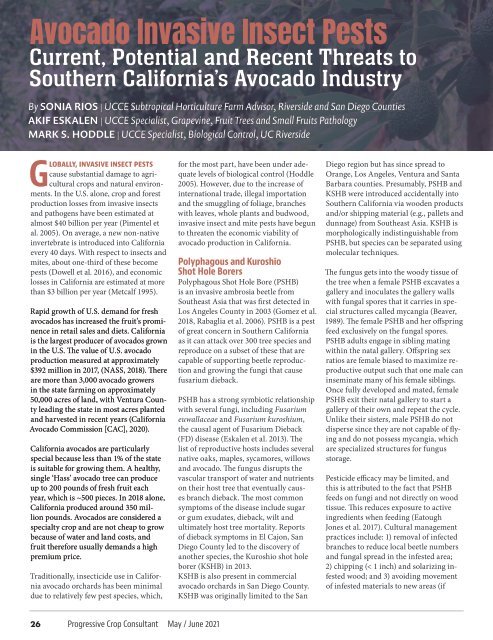Progressive Crop Consultant May/June 2021
Create successful ePaper yourself
Turn your PDF publications into a flip-book with our unique Google optimized e-Paper software.
Avocado Invasive Insect Pests<br />
Current, Potential and Recent Threats to<br />
Southern California’s Avocado Industry<br />
By SONIA RIOS | UCCE Subtropical Horticulture Farm Advisor, Riverside and San Diego Counties<br />
AKIF ESKALEN | UCCE Specialist, Grapevine, Fruit Trees and Small Fruits Pathology<br />
MARK S. HODDLE | UCCE Specialist, Biological Control, UC Riverside<br />
Globally, invasive insect pests<br />
cause substantial damage to agricultural<br />
crops and natural environments.<br />
In the U.S. alone, crop and forest<br />
production losses from invasive insects<br />
and pathogens have been estimated at<br />
almost $40 billion per year (Pimentel et<br />
al. 2005). On average, a new non-native<br />
invertebrate is introduced into California<br />
every 40 days. With respect to insects and<br />
mites, about one-third of these become<br />
pests (Dowell et al. 2016), and economic<br />
losses in California are estimated at more<br />
than $3 billion per year (Metcalf 1995).<br />
Rapid growth of U.S. demand for fresh<br />
avocados has increased the fruit’s prominence<br />
in retail sales and diets. California<br />
is the largest producer of avocados grown<br />
in the U.S. The value of U.S. avocado<br />
production measured at approximately<br />
$392 million in 2017, (NASS, 2018). There<br />
are more than 3,000 avocado growers<br />
in the state farming on approximately<br />
50,000 acres of land, with Ventura County<br />
leading the state in most acres planted<br />
and harvested in recent years (California<br />
Avocado Commission [CAC], 2020).<br />
California avocados are particularly<br />
special because less than 1% of the state<br />
is suitable for growing them. A healthy,<br />
single ‘Hass’ avocado tree can produce<br />
up to 200 pounds of fresh fruit each<br />
year, which is ~500 pieces. In 2018 alone,<br />
California produced around 350 million<br />
pounds. Avocados are considered a<br />
specialty crop and are not cheap to grow<br />
because of water and land costs, and<br />
fruit therefore usually demands a high<br />
premium price.<br />
Traditionally, insecticide use in California<br />
avocado orchards has been minimal<br />
due to relatively few pest species, which,<br />
for the most part, have been under adequate<br />
levels of biological control (Hoddle<br />
2005). However, due to the increase of<br />
international trade, illegal importation<br />
and the smuggling of foliage, branches<br />
with leaves, whole plants and budwood,<br />
invasive insect and mite pests have begun<br />
to threaten the economic viability of<br />
avocado production in California.<br />
Polyphagous and Kuroshio<br />
Shot Hole Borers<br />
Polyphagous Shot Hole Bore (PSHB)<br />
is an invasive ambrosia beetle from<br />
Southeast Asia that was first detected in<br />
Los Angeles County in 2003 (Gomez et al.<br />
2018, Rabaglia et al. 2006). PSHB is a pest<br />
of great concern in Southern California<br />
as it can attack over 300 tree species and<br />
reproduce on a subset of these that are<br />
capable of supporting beetle reproduction<br />
and growing the fungi that cause<br />
fusarium dieback.<br />
PSHB has a strong symbiotic relationship<br />
with several fungi, including Fusarium<br />
euwallaceae and Fusarium kuroshium,<br />
the causal agent of Fusarium Dieback<br />
(FD) disease (Eskalen et al. 2013). The<br />
list of reproductive hosts includes several<br />
native oaks, maples, sycamores, willows<br />
and avocado. The fungus disrupts the<br />
vascular transport of water and nutrients<br />
on their host tree that eventually causes<br />
branch dieback. The most common<br />
symptoms of the disease include sugar<br />
or gum exudates, dieback, wilt and<br />
ultimately host tree mortality. Reports<br />
of dieback symptoms in El Cajon, San<br />
Diego County led to the discovery of<br />
another species, the Kuroshio shot hole<br />
borer (KSHB) in 2013.<br />
KSHB is also present in commercial<br />
avocado orchards in San Diego County.<br />
KSHB was originally limited to the San<br />
Diego region but has since spread to<br />
Orange, Los Angeles, Ventura and Santa<br />
Barbara counties. Presumably, PSHB and<br />
KSHB were introduced accidentally into<br />
Southern California via wooden products<br />
and/or shipping material (e.g., pallets and<br />
dunnage) from Southeast Asia. KSHB is<br />
morphologically indistinguishable from<br />
PSHB, but species can be separated using<br />
molecular techniques.<br />
The fungus gets into the woody tissue of<br />
the tree when a female PSHB excavates a<br />
gallery and inoculates the gallery walls<br />
with fungal spores that it carries in special<br />
structures called mycangia (Beaver,<br />
1989). The female PSHB and her offspring<br />
feed exclusively on the fungal spores.<br />
PSHB adults engage in sibling mating<br />
within the natal gallery. Offspring sex<br />
ratios are female biased to maximize reproductive<br />
output such that one male can<br />
inseminate many of his female siblings.<br />
Once fully developed and mated, female<br />
PSHB exit their natal gallery to start a<br />
gallery of their own and repeat the cycle.<br />
Unlike their sisters, male PSHB do not<br />
disperse since they are not capable of flying<br />
and do not possess mycangia, which<br />
are specialized structures for fungus<br />
storage.<br />
Pesticide efficacy may be limited, and<br />
this is attributed to the fact that PSHB<br />
feeds on fungi and not directly on wood<br />
tissue. This reduces exposure to active<br />
ingredients when feeding (Eatough<br />
Jones et al. 2017). Cultural management<br />
practices include: 1) removal of infected<br />
branches to reduce local beetle numbers<br />
and fungal spread in the infested area;<br />
2) chipping (< 1 inch) and solarizing infested<br />
wood; and 3) avoiding movement<br />
of infested materials to new areas (if<br />
26 <strong>Progressive</strong> <strong>Crop</strong> <strong>Consultant</strong> <strong>May</strong> / <strong>June</strong> <strong>2021</strong>


















